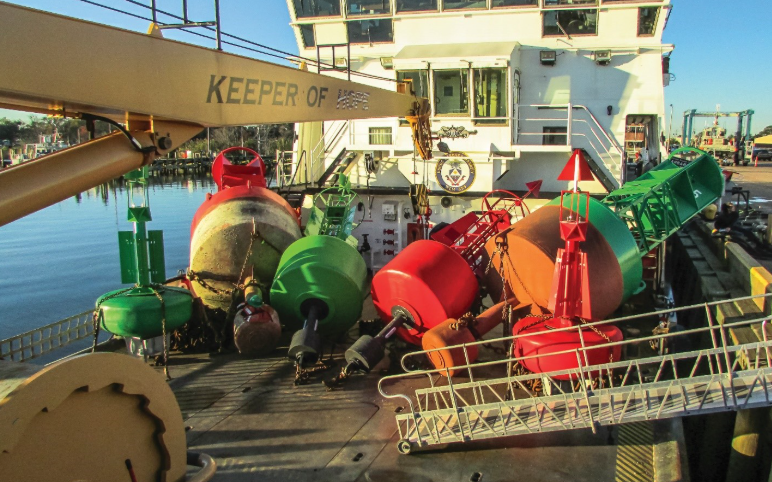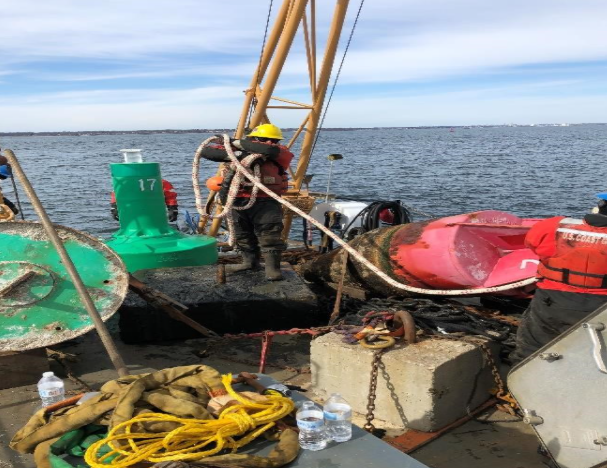May 23, 2025 —

A mix of next-generation and legacy buoys on Coast Guard Cutter Barbara Mabrity. U.S. Coast Guard photo.
The Coast Guard Research and Development Center (RDC) conducted a multi-year study to evaluate whether transitioning to next-generation or “next-gen” aids-to-navigation (ATON) buoys would prove to be more cost-effective than the steel buoys that are currently used. Sponsored by the Shore Infrastructure Logistics Center’s Waterways Operations Product Line (SILC-WOPL), the project resulted in recommendations on buoy classes that could be replaced with next-gen capabilities and potential locations for future deployment.
Next-gen buoys are commercially available assets made of hard-shelled plastic or foam or hybrid designs such as plastic and metal. These “newer” buoys are widely used by coast guards and maritime organizations worldwide. They are generally lighter, require less maintenance and may result in cost savings compared to steel-based buoy designs that the Coast Guard mainly uses today.
The Coast Guard is responsible for setting and maintaining an extensive ATON buoy inventory from inland rivers and coastal inlets to open ocean environments. The evaluation showed that it may be more cost-effective to replace small- to mid-size buoys in protected waterways such as harbors up to semi-exposed locations like bays. Large steel buoys still seem to offer the best tradeoffs between performance, survivability and value for exposed locations like the open ocean.
“The big advancement in the new designs compared to the steel-based buoys that were designed 50 or 60 years ago are in the lights themselves that go on top of the buoy,” said James Spilsbury, RDC research lead on this project. “The steel buoys were designed to house large battery banks and solar panels to keep the lights running. The new light-emitting diode or LED lanterns that the Coast Guard uses on buoys today are compact, energy-efficient and do not require large battery banks to power them.”
“WOPL wanted to know, when compared to our legacy inventory, if these next-generation buoys could meet mission requirements and possibly offer aids to navigation program cost savings through less maintenance, new hull replacements and overall lower life-cycle costs,” said Karin Messenger, Environment and Waterways portfolio manager for the Office of Research, Development and Innovation.
“Next-gen buoys represent an opportunity to modernize the ATON system to help the Coast Guard achieve cost efficiencies while still performing the mission at a high level of service,” Spilsbury said.
The team also considered alternative mooring technologies, such as synthetic rope and stretch hose, for use with ATON in lieu of the traditional chain mooring systems. It was determined that the alternatives showed promise for use on small- to medium-sized buoys in protected areas with limited sea state, but Coast Guard crews faced significant operational challenges due to the lack of appropriate deck equipment for hauling rope under strain.
WOPL leaders are happy with the way the RDC conducted the tests and the data the project provided.
“The RDC has been tremendously helpful and their ability to test buoys from an objective and scientifically based perspective gives us the confidence to smartly implement recommendations and have a high probability of success,” said Cmdr. Jeffrey Zamarin, SILC-WOPL project manager. “Understanding the risks and potential benefits ahead of making procurement and operational decisions for new buoy options allows us to most effectively utilize our resources, and that is a tremendous value for us.”
He added: “The information from this study helps to inform our decision space regarding what buoy options are viable for the Maritime Transportation System. It also helps to objectively determine which buoy type is most economical from a life-cycle perspective for the myriads of environmental conditions. It provided insights on several operational considerations and factors Coast Guard decision makers need to consider to successfully implement the technology at scale including design improvements, operational compatibility, training, disposal and recycling.”
The RDC will continue to leverage its expertise and advise the Coast Guard on transitioning the technology to operational use, Spilsbury said.

A Coast Guard crew pulls in buoys that were part of a field study to determine how next-generation buoys compare to the steel buoys currently in use. U.S. Coast Guard photo.
For more information: Research and Development Center page and Research, Development and Innovation Program page